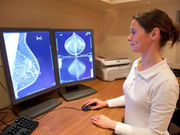Biannual automated breast ultrasound may not add value to annual mammography, MR imaging
MONDAY, Oct. 30, 2017 (HealthDay News) — Automated breast ultrasonography may not be of added value to yearly full-field digital (FFD) mammography and dynamic contrast agent-enhanced (DCE) magnetic resonance (MR) imaging surveillance of carriers of the BRCA mutation, according to a study published in the November issue of Radiology.
Jan C.M. van Zelst, M.D., from Radboud University Medical Centre in the Netherlands, and colleagues prospectively followed 296 carriers of the BRCA mutation (153 BRCA1 and 128 BRCA2 carriers, plus 15 women with first-degree untested relatives) using two years of intensified surveillance including biannual automated breast ultrasound as well as routine yearly DCE MR imaging and FFD mammography.
The researchers found that breast cancer was screening-detected in 16 women. Sensitivity of DCE MR imaging, FFD mammography, and automated breast ultrasound was 68.1 percent, 37.2 percent, and 32.1 percent, respectively, while specificity was 95 percent, 98.1 percent, and 95.1 percent, respectively. For the three modalities, the cancer detection rate was 2, 1.2 percent, and 1 percent per 100 women-years, while positive predictive value was 25.2 percent, 33.7 percent, and 9.5 percent. The highest sensitivity — 76.3 percent — was seen with the combination of DCE MR imaging and FFD mammography, which had a specificity of 93.6 percent. Automated breast ultrasound depicted no additional cancers, and FFD mammography did not yield additional cancers in women younger than 43 years, the mean age at diagnosis.
“Study results suggest that carriers of the BRCA mutation younger than 40 years may not benefit from FFD mammography surveillance in addition to DCE MR imaging,” conclude the authors.
Two authors disclosed financial ties to the medical device and imaging industries.
Copyright © 2017 HealthDay. All rights reserved.








